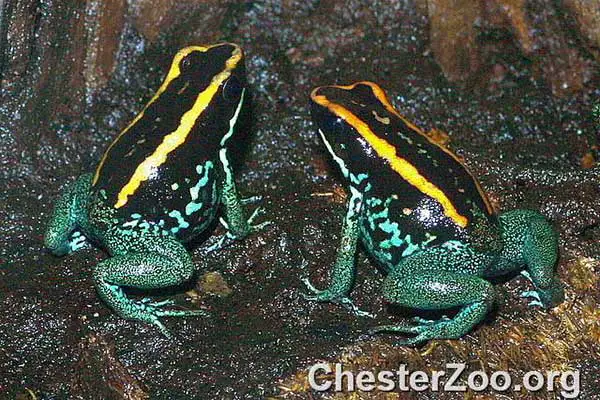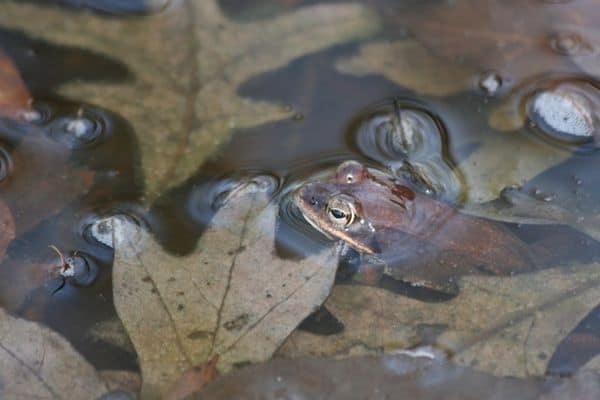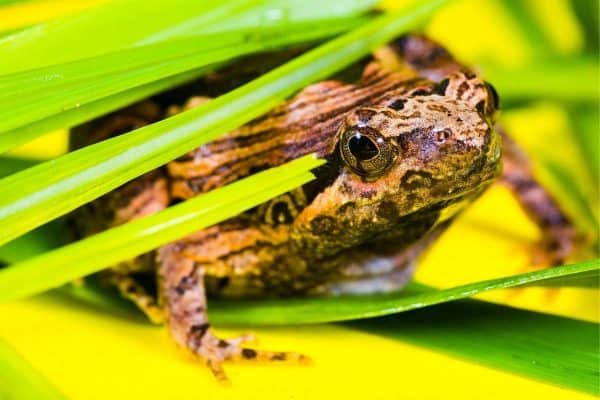If you have ever trekked through the wilderness at night and heard a chorus of frogs, you were listening to frog communication. When you think of frog communication, you may think of “ribbit” or croaking, but there’s more than that. Frog communication is actually quite complex and sophisticated. They have a range of sounds and calls to attract mates and ward off intruders. Frogs also use physical touch and body language to communicate with others. This article explores the ways that frogs communicate with each other.
Key Takeaways
- Frog communication is actually very complex and varies by species and even region.
- Male frogs use vocalization to call females, and female frogs are usually attracted to the loudest, longest calls.
- Some frog species use behaviors to communicate, such as waving their arms, shaking, or posturing by puffing up.
- Frogs communicate through touch also, like a female nudging a male or touching his leg to initiate mating.
How Do Frogs Communicate

Frogs communicate with each other in a variety of complex ways. They use vocalization during mating season. They also use body movements, behaviors, visual cues, and touch to communicate with each other.
Complexities in Frog Communication

Frog communication is more complex than you might think. Different species of frogs communicate with each other in different ways. Some frog species use a variety of communication methods depending on what they’re trying to accomplish.
Frogs often communicate by combining all of the methods we discuss. Younger male frogs mimic older males to learn how to call a female. Repeating patterns become established in some areas.
Studies show that some species isolated in a certain area adapted their own unique ways of communicating not seen anywhere else. Frogs also have regional dialects and “accents.” In fact, some species of frogs staying in the same pond can develop their own series of calls unique to that pond.
Distinct call patterns can last for generations. Frog communications are extremely complex. Scientists are still trying to understand all of the combinations of communication methods frogs use with each other.
Vocalization

Different frog species produce different kinds of vocalizations for communicating with each other. Depending on the time of year and reasons for vocalization, frogs may change their calls. Most frogs use croaks, ribbits, trills, and various calls to communicate during mating season and to establish territory.
Each frog species has a different sound, and even the same species vary. For example, male green tree frogs sit on a leaf over a pond to call females. Several, possibly hundreds, of males croak and squeak, each with a different pitch and sound.
Interestingly, female green tree frogs are able to isolate one male’s call out of hundreds. She then travels to find him. Females are usually attracted to the loudest, longest calls.
Male bullfrogs attract a mate by sitting in or beside water a letting out a deep trill or grumbling sound. They also expand a huge throat pouch to intimidate rival males while vocalizing. Many male frog species use a combination of vocalization and body movements to communicate aggression towards another male.
They can be extremely territorial. Generally, female frogs of most species are not as vocal as males. However, some female frogs make sounds during mating to arouse their mate.
Vocalization is a complex way that frogs communicate with each other. Their range of sounds and changes in calls indicate that frogs produce sophisticated vocalizations for communicating.
Behavioral Communication

Different frog species display various behaviors to communicate with other frogs. Males may use aggressive posturing behaviors to ward off rival males. Male frogs also have behaviors they display during courtship rituals with females.
For example, male Brazilian torrent frogs bob their heads, tap their toes, and wave their arms. In some species, a male shakes and vibrates to convince a female to mate. This is called tremulation.
Some species of glass frogs wave their arms and legs to attract females while he also “quacks.” The same behavior is performed to fend off predators or other males. Two male frogs communicate by posturing in aggressive ways.
Why Do Frogs Puff Up
Some male frogs puff up their body to look larger in order to intimidate an encroaching rival. The same shaking tremulation performed for mating is also used to establish dominance and claim territory. For instance, the red-eyed green tree frog uses tremulation against intruders.
Behavioral communication and body language is another complicated way that frogs communicate with each other. Body language can convey aggression or can be friendly.
Physical Touch

Most frog species initiate mating through physical touch. This kind of frog communication includes nudging, grabbing, or a simple touch performed by either the male or female. Male frogs grab females and ride their backs during mating.
This act is called amplexus and communicates to the female that he is ready to mate. But how does he know the female frog is ready? Sometimes a male might attempt amplexus and be denied until she is ready.
Females kick males off if they’re not ready to mate. Denying a male communicates to him that either he’s not what she’s looking for or she’s simply not ready at the moment. Some female frogs nudge her mate to give him the green light that she’s ready for mating.
Others may touch the male’s leg or foot as a way to communicate consent for mating. Finally, male frogs communicate dominance over other male frogs through combat. Some species of frogs fight over territory and mates.
Fighting can look like two frogs engaged in a wrestling match. Frog combat also comes in the form of one male biting and grabbing another male. They may let out cries or squeaks.
Physical touch between frogs is a form of communication that can be intimate or intimidating, depending on the circumstances. Both males and females engage in some form of physical touch communication.
Why Do Frogs Sit on Each Other
Frogs sitting on each other, also known as “stacking” or “piling,” is a behavior observed in various frog species and serves multiple purposes in their natural environment. One primary reason for this behavior is thermoregulation. Frogs are ectothermic, meaning they rely on external sources to regulate their body temperature.
By stacking on top of each other, frogs can share body heat, aiding in maintaining optimal temperature levels, especially during cooler periods. Another reason for this behavior is often associated with breeding. Male frogs may climb atop females as part of the mating process, securing their position for amplexus, a process where the male clasps the female to facilitate the transfer of sperm.
Additionally, stacking may occur in communal living situations, such as shared basking spots near bodies of water, providing social benefits and protection against predators. This behavior reflects the fascinating and adaptive strategies that frogs employ in their ecological niches.
Conclusion
Frogs communicate with each other in complex ways. Vocalization is the communication that we’re most familiar with. However, they also use behavioral body language and physical contact to communicate with each other.



